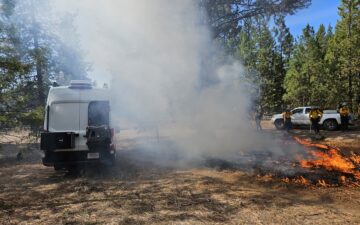
A team of scientists at the University of Washington Applied Physics Laboratory have developed an ice probe capable of burrowing deep into the ice shelf – and sending back data – in a fraction of the time taken by traditional ‘boring’ methods.
The Ice Diver has a heated tip capable of delivering up to 8kW of energy and carries a cargo of 9000 metres of combined cable and fibre optic in its 2 ½” diameter x 11′ long tube.
The power and data cable is payed out as the steerable probe heats its way deep into the ice at a speed of 3.14 m/hr. As it descends, the ice – which could be as cold as minus 60°C – refreezes behind the non-recoverable probe.
The probe is designed to melt its way down through 3000m of ice to the bedrock below, gathering climate data as it explores ice which was laid down up to a million years ago. For the journey the ice probe needs to carry 6000m of out-and-return power cable, plus a fibre optic cable which sends back temperature and dust layer data from the laser scanner.
In order to reduce voltage drop whilst delivering 8kW of energy along 6 kilometres of necessarily very thin power cable, the voltage has to be stepped up to 4000VDC.
To prove the technology the research team – Ben Brand; Justin Burnett; Madison Pickett and Sophia Wensman – spent three and a half weeks camping on the Greenland Glacier in temperatures between -5C and -35C. Their prototype unit dived to a depth of 1200 feet allowing them to compare the data they received with the known data from previous ice core extraction. Their results were ratified – but their probe is capable of reducing the bore time through three kilometres of ice from years to a projected 21 days, whilst using a fraction of the equipment – reducing logistics and set up time.
The probe design had to overcome numerous technical hurdles. The melting head is heated by what Ben Brand jokingly describes as toaster wire. The amount of heat generated can be controlled, and the probe can be steered to some extent as it descends. The sensitive laser, associated electronics, and the 9km of cable must remain unaffected by the 8kW heat output in the nosecone. The probe body must be kept warm to a lesser extent to allow it to follow through without freezing.
Dust layers trapped in the ice tell the story of the earth’s climate and volcanic activity over the millennia. An on board laser reads the dust layers as the probe dives ‘like a bar code‘ says Ben; and the information can be used to date the ice layers – much as dendrochronologists are able to date timber samples from their ring-growth pattern.
The ice temperature is also recorded – deep ice is warmer than ice near the surface: Greenland ice is -30C at the surface and all the way down to 2000m; deeper than that the ice temperature begins to rise from -30C to -4C at the bedrock. In Antarctica the surface temperature is -60C at the surface – also rising to -4C at the bedrock.
The principal power source for the operation is a 45kVA generator – seemingly overpowered for the scientists’ camp requirements, but it will have a future polar-base purpose unrelated to this project. It’s also true that in the arctic climate a generator power output de-rating of between 30% and 50% must be applied.
It is essential that the power supply to the probe is uninterrupted and for that reason three MultiPlus -II 48/3000 inverter/chargers, arranged for 3-phase power supply and connected to three 100Ah batteries (offering storage of 15kWh) was included in the power installation. In fact, on two occasions the generator failed – probably due to air in the fuel from a cracked pipe – and the Multis, detecting the power drop, immediately stepped in to take over the power supply to the probe. The switch-in time for the MultiPlus is less than 20 milliseconds. If the power supply is lost to the probe – even for a short time – there is a danger that it will become permanently iced-in and unable to continue its research work. The power installation was controlled and harmonised by a Cerbo GX communication centre device.
Ben says he really appreciated the convenience of being able to monitor the power status of the programme from anywhere on camp using Victron’s remote monitoring platform VRM. When he was off-duty, or the probe was not operating, it allowed him to stay in touch with the project from anywhere, reassuring himself that that all was well, and allowing him peace-of-mind without being stuck in the operations tent.
VRM can keep you informed by email or push notification about unexpected changes to your system’s status – whether you monitor one installation, or hundreds.
The team is back home now assimilating the lessons they learned into their next Ice Diver probe.










